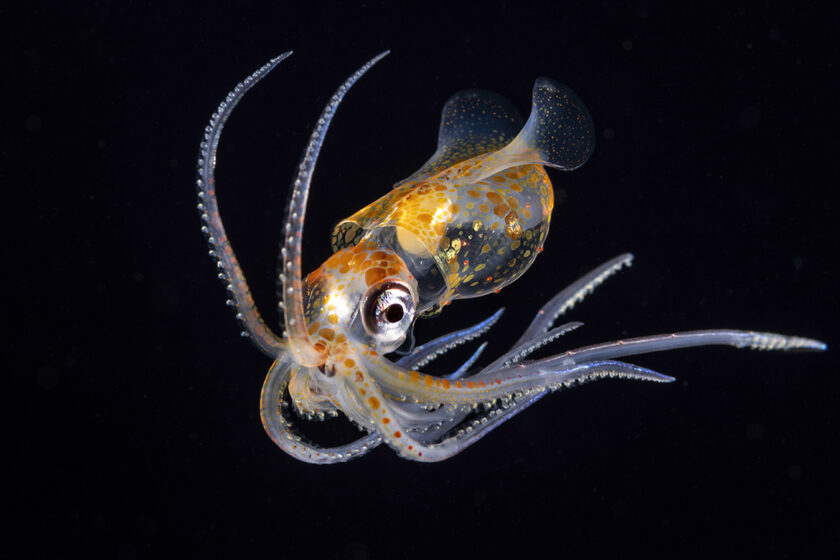Blackwater photography has become one of the hottest forms of underwater macro photography due to rich and highly varied subject matter, and of course the challenge of taking on something new. We all love a challenge.
Just so that you are forewarned: there is a considerable learning curve to mastering blackwater photography. I often think of blackwater photography more along the lines of blackwater-photo-masochism. Even the most experienced underwater photographers often come away from their first blackwater endeavors with their tails tucked between their legs feeling a state of complete photo-frustration. I can’t assure you that you won’t undergo this humbling experience, but I can lend a few pointers and tips to give first-time black water shooters a proper leg up.
Your Photo System – What lens should you use?
Remember, most blackwater subjects are very small. Many are no larger than a fingernail. Whether your system is a housed DSLR or mirrorless, a good sharp macro lens is a necessity. Given that the depth of field of any given macro lens can be paper-thin, the preferred lens choices for blackwater shooters are macro lenses in the 40mm to 60mm range for the following reasons:
- They provide a bit more depth of field than lenses with a longer focal length.
- Yes, the working distance needed to get that 1:1 ratio does require you to work closer, but in blackwater that is almost never an issue.
- Macro lensed with a shorter range generally have a quicker and more responsive focusing speed to track small moving subjects, and these creatures can move.
- Longer macro lenses like a 100 or 105 are generally more difficult to frame and track a subject through the viewfinder and you will also be shooting at something a little further away, placing more water between the subject and the lens. This can affect the lighting provided by your strobes.
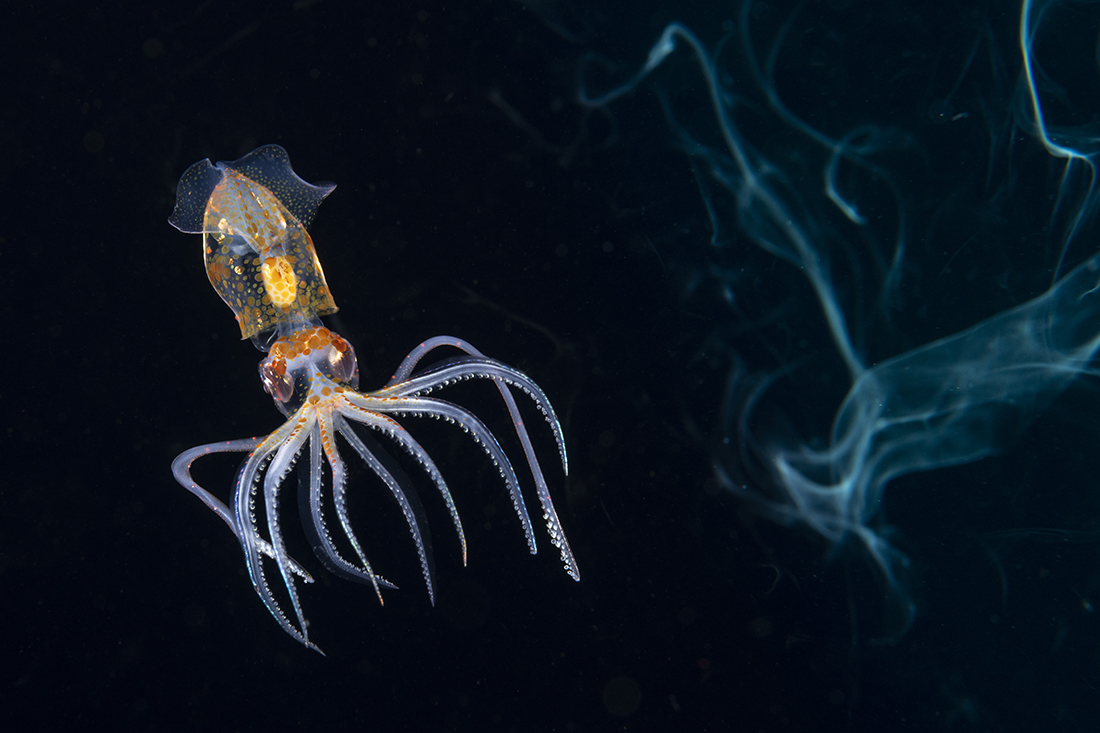
Camera info: Nauticam housed Nikon D850 with 60mm macro lens. Settings: 1/125 sec. at f/19, ISO 280. Lighting provided by two Retra UWT Prime strobes at ¾ power, with two Kraken Sport focus lights.
Unlike sedentary subjects found on the substrate, blackwater subjects are never inactive. Although some subjects tend to drift and pulsate passively with the current, others are sure to behave erratically by spinning and rolling all over the place, or suddenly jet off to one side or the other and out of frame. Sometimes it’s best to watch your subject for a moment to better anticipate their pattern of movement.
Autofocus
On your DLSR / Mirrorless autofocus selector mode start off with the smallest to second smallest focus point provided in your camera as it will provide the quickest focusing response with your macro lens.
Most photographers also agree that single spot focus works better rather than grouped focus points. This way, dropping your focus point over the eye of the subject will ensure that you are focused on the correct point. For cameras with slower auto focus, single shot auto focus will be a better friend than using continuous focus mode. When working close on moving subjects, target the eyes, provided you can identify where they are.
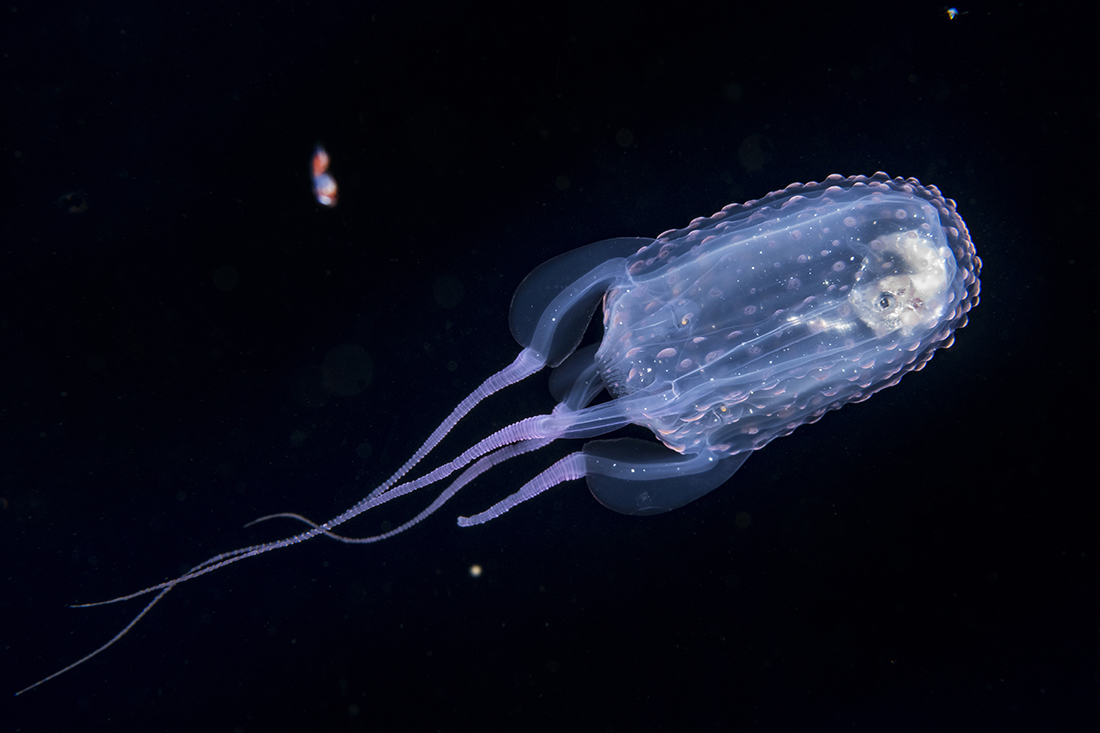
Camera info: Nauticam housed Nikon D850 with 60mm macro lens. Settings: 1/180 sec. at f/16, ISO 400. Lighting provided by two Retra UWT Prime strobes at ¾ power, with two Kraken Sport focus lights.
If your camera should feature a back-focus button setting, use it! Using this function allows you to separate the focus mechanism from shutter release so that you can engage the autofocus by touching the back button focus, which will help you to quickly focus on the subject when needed. There’s nothing worse than returning to your computer to find your images are soft around the eyes of your subject.
Experience has shown back button focus to be the most effective for capturing the subject moving or being still. The back button thumb paddle is easily accessed when shooting and activated with your thumb while the shutter is released with your index finger.
Strobes & Lights
Just as important as finding the right camera/lens combo is making sure you have the proper lighting to capture your images. For flash lighting, there is bevy of underwater strobe models that will certainly do the job. Backscatter’s Mini Flash 1 and 2 along with their new Hybrid Flash (HF-1), Ikelite’s Substrobe DS series, Inon’s D200 to Z330s, OneUW, all models of Retra UWT flash systems, Scubalamp SUPE’s, Sea & Sea’s YS-D1 – D3s, Seacam’s 60 and 160 models, certainly make the list. Among the new kids on the block, there is Kraken Sports new KS160 and Marelux’s all new Apollo III and S model strobes, which have just begun a following.
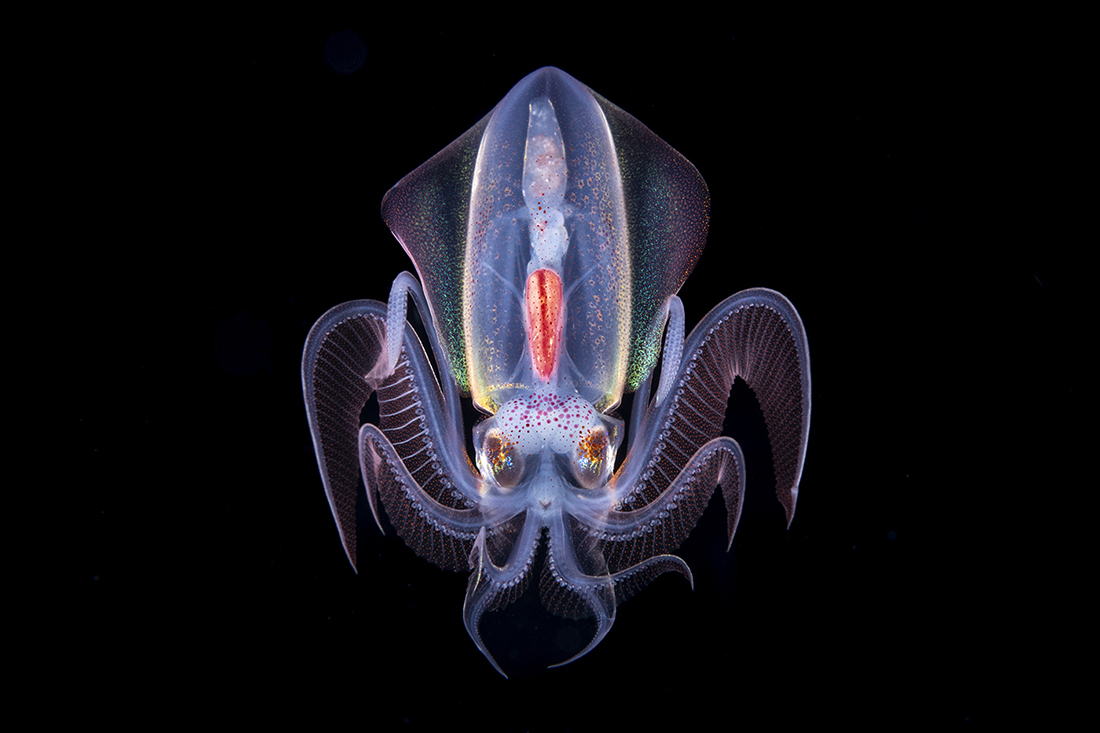
Settings: 1/250 sec. at f/22, ISO 400. Lighting provided by two Retra UWT Prime strobes at power, with two Kraken Sport focus lights.
As added note here, some the above mentions strobes have the ability for fast recycling when set in the neighborhood of ¾ power, allowing you to pull off a quick series of 4 to 6 plus consecutive shots. This is a real asset when dealing with fast, erratic moving targets.
Two vs. One
A single strobe is okay when positioned at the 12:00, but two strobes are preferred. I have even witnessed the use of a Inon S2000 series strobe as a kicker flash mounted in 12 O-clock position above the macro port. But more doesn’t always equal better, and I find streamlining the system is better than overloading myself. Furthermore, that space above the camera is better served for your focus lights. Currently BigBlue, Kraken Sport and Weefine are among the most popular.
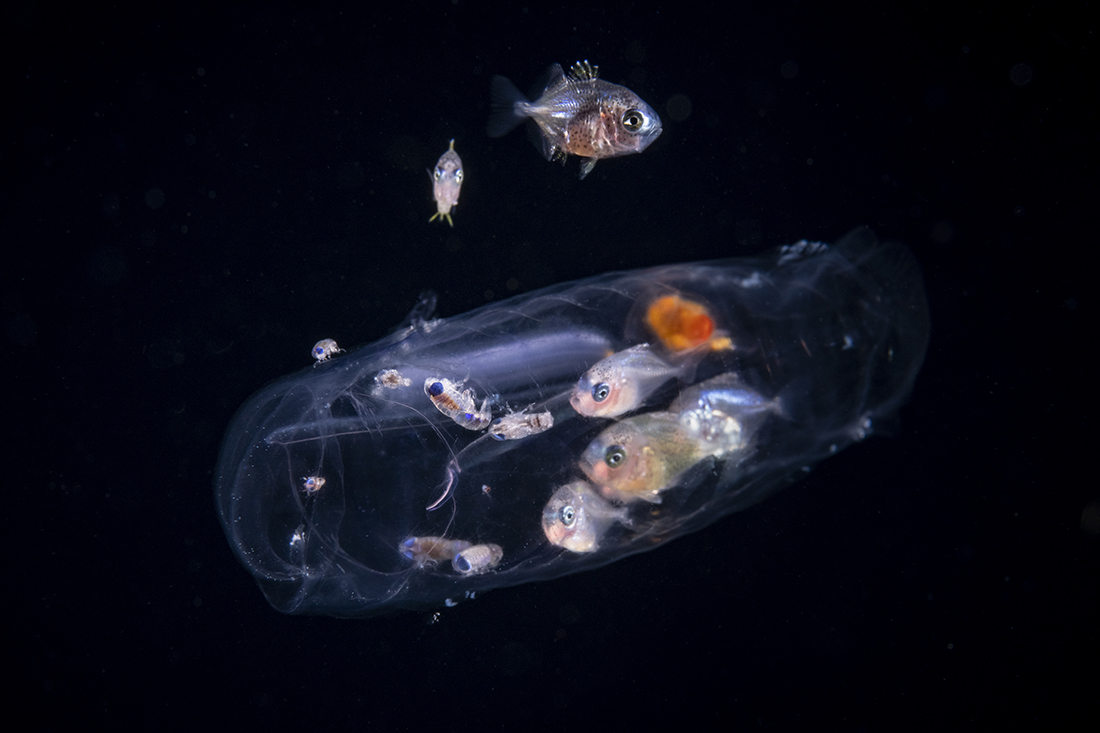
Camera info: Nauticam housed Nikon D850 with 60mm macro lens. Settings: 1/180 sec. at f/22, ISO 400. Lighting provided by two Retra UWT Pro Max strobes at ¾ power facing one another from opposites sides of the salp, with two Kraken Sport focus lights to keep will illuminated during shooting.
Again, you are in a really dark environment with little to nothing reflecting back other than what is suspended in the water column. One really powerful focus lght is good, but having two on camera is better. I know of couple of avid blackwater shooters who go to the extent of mounting four such lights on their housing. When seen in the dark, I am reminded of the scene from movie Close Encounters of the Third Kind.
One of the tools I seldom see mentioned are handheld lights with a tighter beam angle than those found in most focus lights. My personal preferences are Kraken Sports’ NR-1500 with 1500 Lumens and Dive Rite’s CR2 with 1700 Lumens at max power. Both feature a fixed focus, smooth reflector providing an 8 to 10-degree beam.
Compared to the softer beam cast of a focus light, or a video light for that matter, their design provides a more intense throw of light is that is better suited for hunting and singling out a possible prospect further away.
Light outputs in the 2500 to 5000 lumen range also work, but they can be at times on the side of overkill. Coming back to the Kraken NR-1500’s and Dive Rite’s CR2, both are compact, powered by a single rechargeable 21700 Li-Ion Battery. Most blackwater dives where I live in Palm Beach Florida span 80 to 95-minutes in length, and there are no issues managing the burn time.
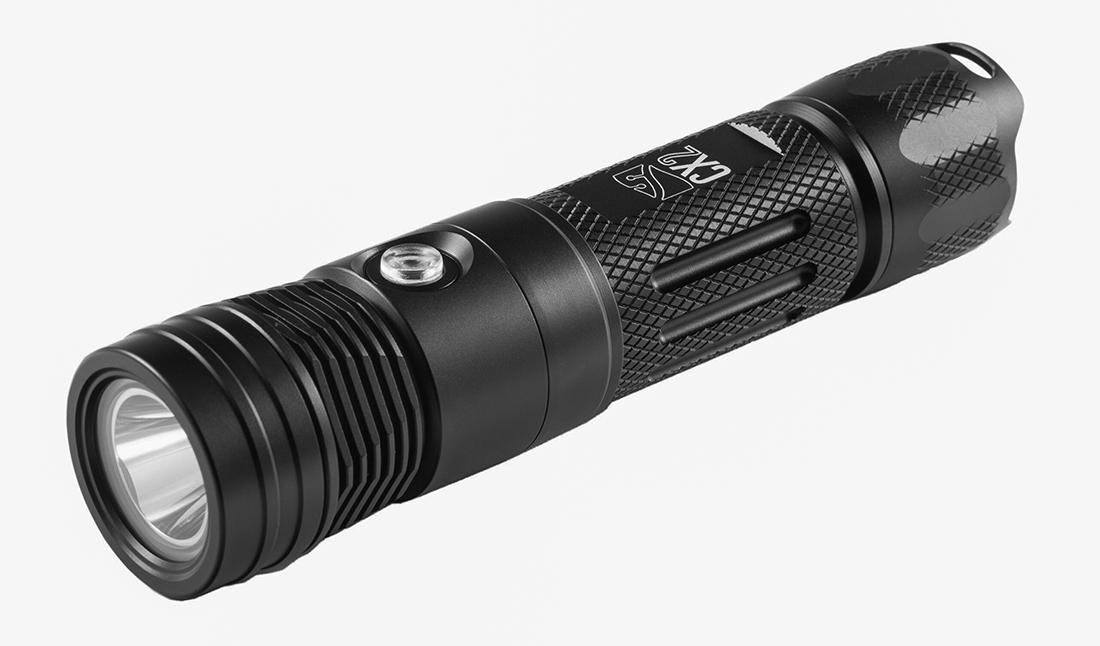
Some divers will attach these tight-beam lights alongside their focus lights on their camera housings. My personal preference is having it a short safety line attached to my BCD so that I can freely hand hold it. This way I can swim with the focus lights on the housing aimed downward to reduce light pollution that might interfere with the spotlight’s greater ability to punch further into the dark. Once something of interest is found, I can smoothly transition from the spot (letting it drop out of the way) to my camera with missing a beat as I come into range.
Exposure to Strobe Placement – The Most challenging Part of Blackwater
Unlike shooting subjects on or near bottom, where we must decide how much of the background we want seen in the background, we are shooting in this 360º environment where no background other than “black” exists. This creates the most challenging part of blackwater photography. By default, we generally follow the exposure triangle used for flash photography.
To get started here are four basic jump-settings to pre-set your camera before going.
Jump Settings:
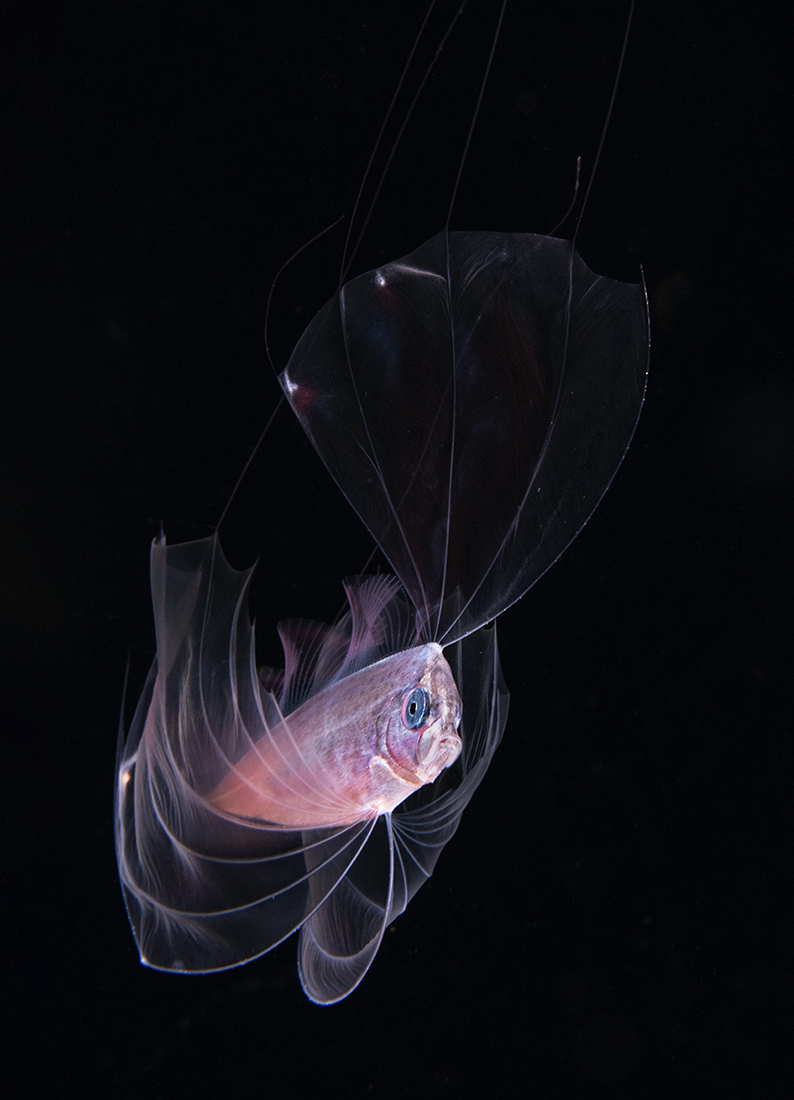
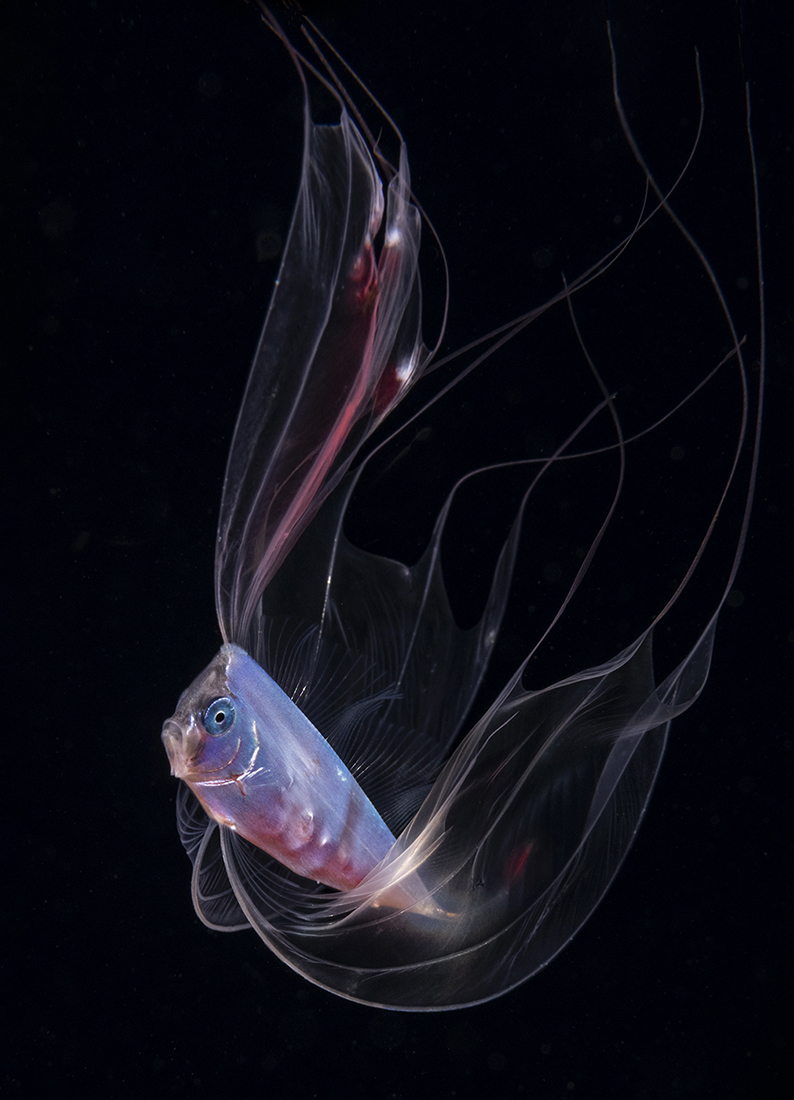
Both ribbon fish were shot with the same camera system and settings: Nauticam housed Nikon D850 with 60mm macro lens. Settings: 1/180 sec. at f/19, ISO 400. Lighting provided by two Retra UWT Prime strobes at ½ power, with two Kraken Sport focus lights. Below is a set of camera settings to jumpstart your endeavor into blackwater photography.
- ISO range 200 to 400 – Using a faster ISO increases light sensitivity which allows for a slightly lower strobe power and faster recycle times.
- Aperture – F/16 to F/19 – Using apertures in this range allows for both excellent depth of field and detail resolution. If you are using a duo strobe setup that has the power and quick recycle time, then you can likely start off with a little bit higher aperture value of F/19 to F/22.
- Shutter speed – 1/125 to 1/200 – A shutter speed of 1/125 to 1/200 of a second will be more than enough to freeze motion to create sharp image from your prized finds. And we can’t forget what background light is there to worry about.
- Strobe power – 75% – Starting here provides better insurance that the light is not only strong enough to light the subject, recycle time will be quicker than on full, not mention getting my mileage out of batteries.
Diffusers on your strobes can help with harsh contrast and reduce the high points slightly while spreading the degree of coverage more evenly. My current Retra UWT Pro Max strobes have a circular flash tube behind a semi frosted dome, making it unnecessary for me to use a diffuser. Taking a few tests shots of your finger held 6 to 9 inches out front the macro port is a great way to get a feel for exposure.
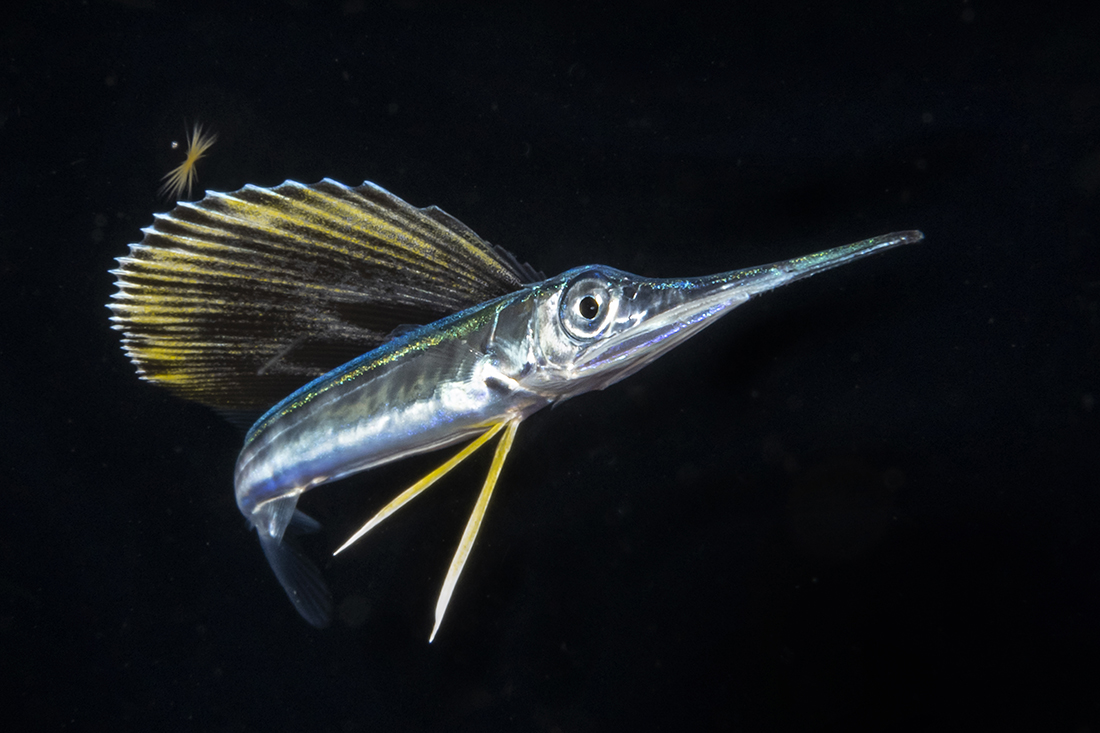
Camera info: Nauticam housed Nikon D850 with 60mm macro lens. Settings: 1/180 sec. at f/22, ISO 280. Lighting provided by two Retra UWT Pro Max strobes at ½ power, with two Kraken Sport focus lights to keep will illuminated during shooting.
As for placement, there are no rules, rather recommendations. You can go with one strobe at the 12:00 O-clock top lighting with another either in the 4:00 or 8:00 O-clock position. A common practice and one I use myself is having both strobe heads at a 9:00 and 3:00 O-clock position placed just beyond the front of the macro port.
While backscatter might be present and create some challenges, the critical part to shooting these tiny creatures is assessing what category they fall in – fully translucent, lightly opaque, reflective to highly reflective like a mirror.
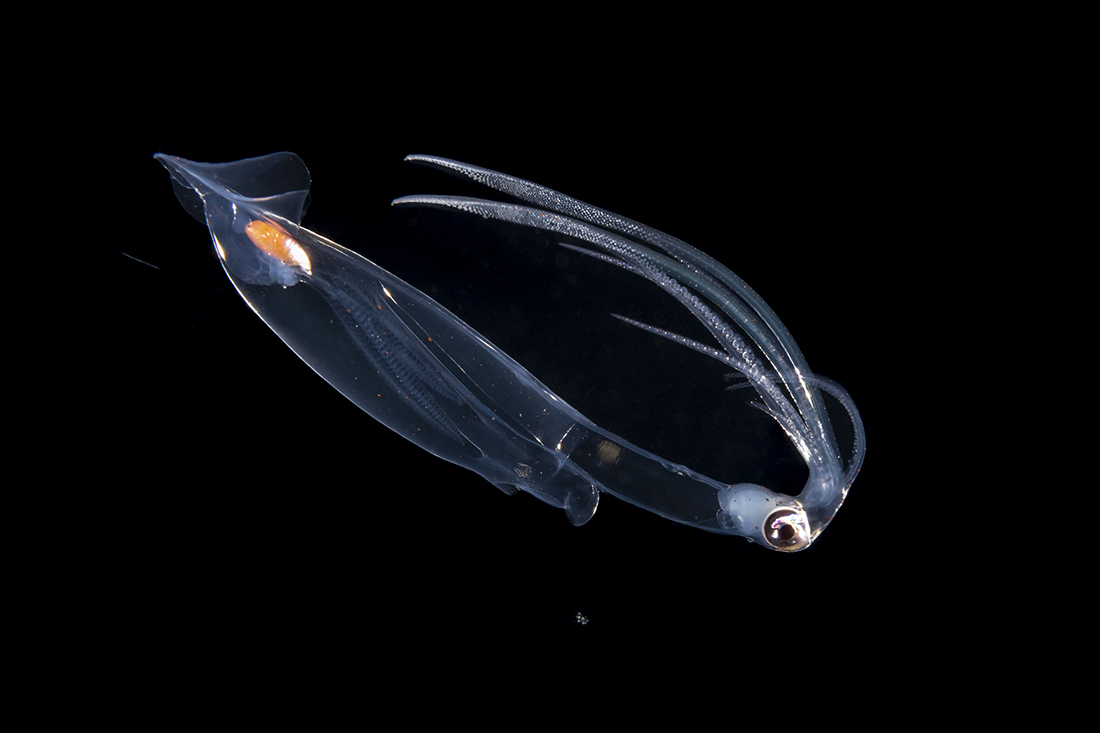
Camera info: Nauticam housed Nikon D850 with 60mm macro lens. Settings: 1/250 sec. at f/22, ISO 400. Lighting provided by two Retra UWT Prime strobes at ¾ power, with two Kraken Sport focus lights.
Dealing with translucent bodies like pelagic tunicates, as known as salps, comb jellies, Siphonophores to sea butterflies (Cavolinia tridentata) requires a little bit of back lighting to enhance their features. This can be done from the strobe position, with a little shift so that they are pointed slightly inward so that half of the light source is coming from behind them.
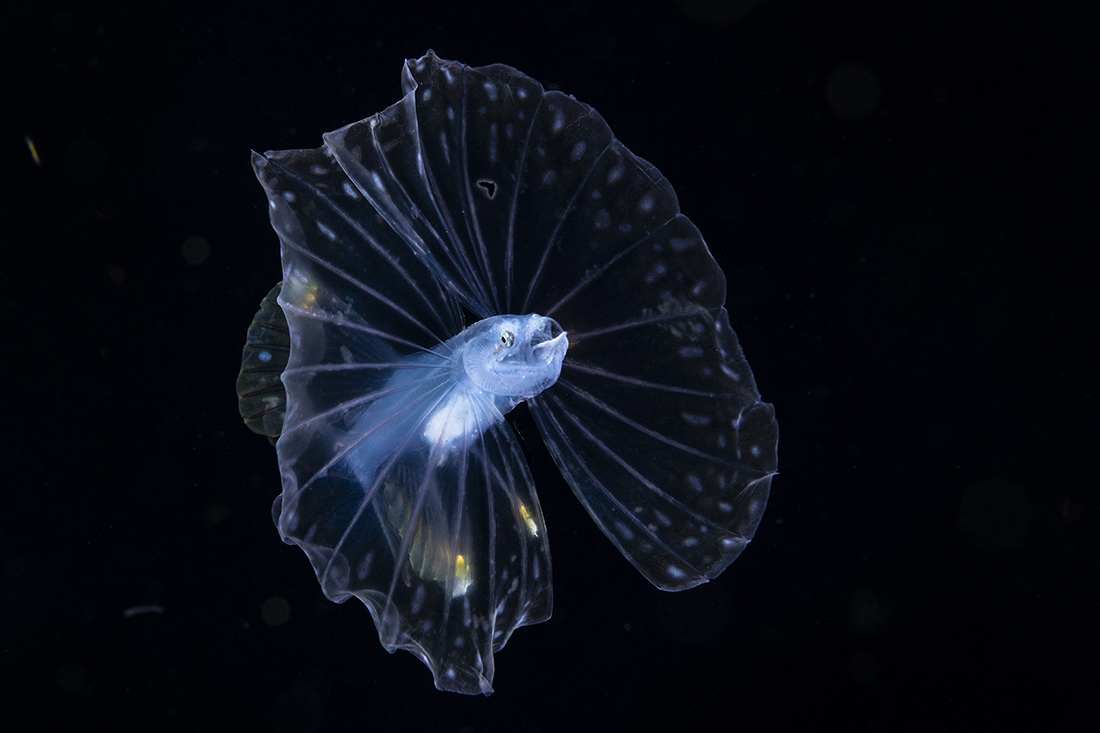
Camera info: Nauticam housed Nikon D850 with 60mm macro lens. Settings: 1/125 sec. at f/19, ISO 280. Lighting provided by two Retra UWT Pro Max strobes at ¾ power, with two Kraken Sport focus lights.
For subjects with bodies that are more opaque than translucent, reconfigure both strobe heads so that they are facing more at each other while they are in the same 9:00 and 3:00 O-clock position. This tactic can really work well on subjects like small squid, larval octopus and small fish with lightly opaque to translucent bodies.
Positioning both strobes next to the lens port can work well for subjects that are very small and need to be as close to the front of the lens port as possible. But leaving them there with a larger subject, or one further away, can be devastating to the shot as the strobe will pick up more backscatter between the lens and subject.
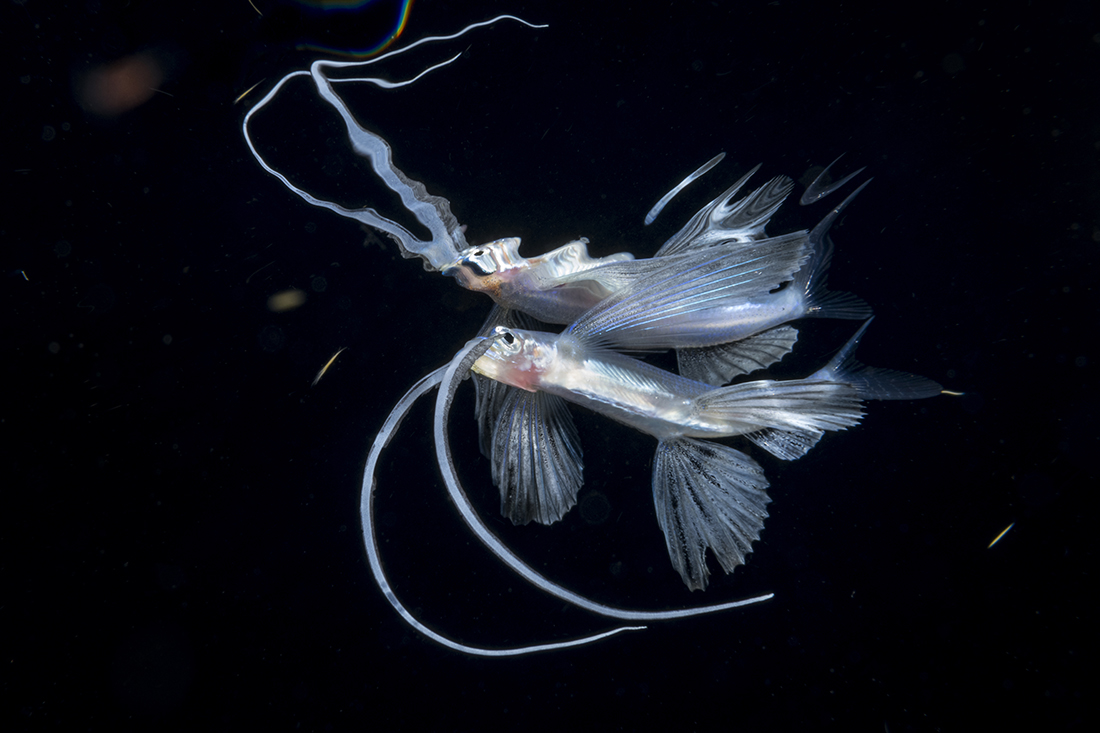
Camera info: Nauticam housed Nikon D850 with 60mm macro lens. Settings: 1/180 sec. at f/22, ISO 280. Lighting provided by two Retra UWT Prime strobes at ½ power, with two Kraken Sport focus lights.
When the seas are glassy calm, some of my favorite subjects include the juvenile flying fish, mahi mahi and sailfish that hang right below the water’s surface, which makes them ideal candidates for that black mirror surface reflection shot. Here again, with 9:00 and 3:00 O-clock position I would aim both strobe heads completely foreword.
Conclusion
As you can see, blackwater is not your run of the mill brand of macro photography. Yes, it certainly has its challenges and expenses in terms of peripheral equipment. But the payoff is well worth the effort. Who knows, you might capture something on one of those nights that has never before been seen alive.
To see what people are shooting on their blackwater dives around the world there is Blackwater photo community on facebook. The “Blackwater Photo group” is a public group with over is 50k members open to anyone who wants to join that is into this type of underwater photography.

